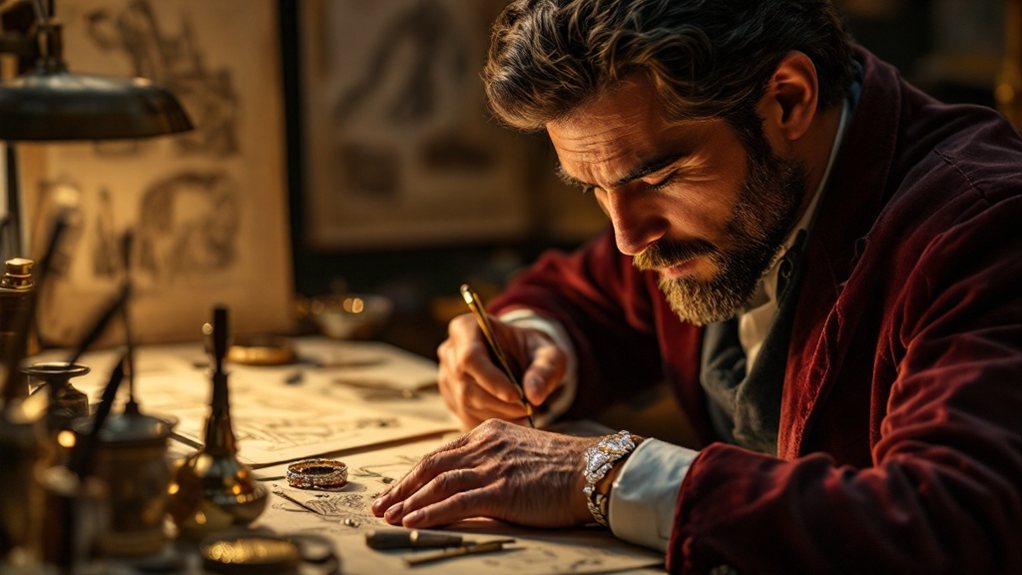Iconic Jewellery Houses and Their Designers: Cartier – The Evolution of a Luxury Jewellery Brand
The Journey of Cartier: From Parisian Workshop to Global Luxury Icon
Cartier’s transformation from a small workshop in Paris to a symbol of global luxury stands as a testament to its innovative spirit and exceptional craftsmanship. Founded in 1847 by Louis-François Cartier, the brand’s rise was characterised by its pioneering designs and endorsements from royalty, earning it the title “jeweller of kings.” Each generation of the Cartier family brought fresh innovations, such as the novel use of platinum, enhancing the brand’s reputation. So, how does Cartier continue to shape modern jewellery design while honouring its rich history? The secret lies in its unwavering dedication to quality and sustainable practices.
“Cartier’s commitment to both tradition and innovation is what keeps it at the forefront of luxury jewellery,” says jewellery historian Emily Davies. “Their ability to blend timeless elegance with modern sustainability efforts is truly remarkable.”
By maintaining these core values, Cartier not only preserves its legacy but also inspires the future of jewellery design.
Article Contents
Cartier: A Legacy of Excellence in Jewellery
Founded in 1847 by Louis-François Cartier in Paris, Cartier made its mark in the luxury jewellery sector early on. With the subsequent involvement of Alfred Cartier and his sons, the brand grew its presence globally, earning a reputation among royalty and the elite.
One of Cartier’s notable contributions to jewellery design was its pioneering use of platinum, which allowed for more intricate and delicate creations. The brand also introduced innovative styles such as the “mystery setting” and the vibrant “Tutti Frutti” pieces, which showcased a blend of colourful gemstones.
Cartier’s association with monarchy, including King Edward VII, who famously referred to the brand as the “Jeweller of Kings”, further cemented its prestige. Today, as part of the Richemont group, Cartier remains committed to pushing the boundaries of design while prioritising sustainable and ethical practices in sourcing materials.
Cartier’s legacy is not just in its exquisite designs but in its unwavering commitment to quality and innovation.
Founding and Early Years
Founding and Early Years of Cartier
The Beginning in Paris
In 1847, Louis-François Cartier took a significant step in the world of luxury when he assumed control of his mentor Adolphe Picard’s workshop in Paris. This period, shortly after the upheaval of the French Revolution, was one of great change and opportunity. Cartier’s entry into the world of jewellery coincided with the rise of the Second Empire, a time when luxury businesses began to thrive. Despite the challenges posed by the 1848 Revolution in France, Cartier managed to survive and establish a foothold in the luxury industry. By the time Alfred Cartier, Louis-François’ son, took over the company in 1874, the brand was already gaining recognition for its craftsmanship and innovation.
Establishing a Royal Connection
By 1859, Cartier had opened his first boutique and caught the attention of notable personalities, including Princess Mathilde and Empress Eugenie. This endorsement was a testament to Cartier’s exceptional craftsmanship and a clever alignment with the preferences of the aristocracy, which helped the brand grow.
The Cartier Family’s Influence
The involvement of the Cartier family became more pronounced under Alfred Cartier‘s leadership in 1874, further enhancing the brand’s reputation.
As his sons Louis, Pierre, and Jacques later expanded the business internationally, the strong foundation built in those early years proved invaluable.
Cartier’s persistence through economic challenges and political changes underscored its dedication to quality and innovation, securing its position as a leading name in luxury jewellery.
Expansion and Innovation
Cartier’s Expansion and Innovation: A History of Excellence
Cartier’s history of expansion and innovation is exemplified by its early adoption of platinum in jewellery craftsmanship. This choice opened up new design possibilities due to the metal’s strength and flexibility, enabling the creation of more detailed and sophisticated pieces. By 1871, Cartier had built a significant jewellery collection after acquiring fine pieces at low prices during the Paris Commune, setting the stage for its future growth. Cartier received a Royal Warrant and supplied jewellery to King Edward VII and his court, which further cemented its status as a jeweller to royalty. As Cartier extended its reach worldwide, establishing boutiques in major cities such as New York and Tokyo, it solidified its reputation as a leading name in luxury and elegance. This strategic growth was not solely about increasing its geographical footprint but also about raising the bar in craftsmanship and innovation, ensuring that Cartier maintained its position at the forefront of the jewellery industry.
“Cartier has always been about pushing the boundaries of what’s possible in jewellery design,” says an industry expert. “Their use of platinum was a game-changer, and their global expansion has only strengthened their influence and presence.”
Pioneering Platinum Jewellery
Cartier, through its innovative application of platinum, transformed the jewellery industry, ushering in a new era of luxury and craftsmanship. In 1890, Cartier unveiled its renowned garland style, which highlighted the potential of platinum to create intricate diamond settings. This special platinum alloy offered a brilliant white surface, enhancing the allure of diamonds and allowing light to pass through them more effectively.
The robustness of platinum enabled delicate handcrafting, facilitating the creation of intricate designs with knife-edged fretwork, millegraining, and micro-prongs. Cartier’s platinum bands range from £1,860 to £3,200, showcasing the value and craftsmanship inherent in these luxurious pieces. As mass production techniques for platinum jewellery developed, die-struck designs and hand fabrication became prevalent, further solidifying platinum’s place in the luxury market.
During the Edwardian era, Cartier’s designs epitomised elegance and sophistication. Platinum’s distinct characteristics made it perfect for setting diamonds, as its inertness ensured secure and efficient placement. Louis Cartier’s pioneering work in 1900 advanced this development further by crafting settings that reduced metal coverage and increased diamond brilliance.
The Guirlande style emerged, noted for its pristine white finish and intricate lines, elevating the standard of luxury jewellery.
Cartier’s impact went beyond its own creations as other jewellery houses began to adopt platinum for its unmatched strength and charm. Despite the competition from white gold, Cartier’s legacy of platinum excellence remains, establishing it as a symbol of refinement and innovation.
Platinum was not merely a material choice; it was a declaration of elegance and durability that forever changed the landscape of jewellery design.
Global Presence Expansion
Cartier’s Path to Global Prominence
In the early 20th century, Cartier embarked on a significant journey of international expansion and innovation, making its mark on the global stage. The opening of the flagship boutique on New Bond Street in London in 1902 signified the brand’s entry into international markets. This set a precedent for cultural adjustments that would characterise its worldwide journey. Cartier’s expansion into international markets was fuelled by its reputation as “The Jeweller of Kings, The King of Jewellers,” a title earned by becoming the official jeweller to 19 royal houses worldwide.
This international venture was strengthened by the 1909 launch of the New York boutique, tapping into the dynamic American market and extending Cartier’s reach beyond Europe. Pierre Cartier’s acquisition of a Fifth Avenue townhouse in 1917, known for trading it for $100 and a pearl necklace, became a symbol of Cartier’s strategic foresight and deep understanding of luxury branding.
![]()
As Cartier’s global presence expanded, so did its dedication to understanding and integrating with different cultures. By setting up boutiques in places like St. Petersburg, Cartier embraced regional subtleties, blending local craftsmanship with its timeless elegance—a strategy that appealed to a varied clientele.
This era was marked by strategic partnerships with local artisans, enabling Cartier to incorporate indigenous materials and techniques, thereby broadening its international appeal.
Following World War II, Cartier’s charm grew even more as its creations adorned Hollywood stars and international celebrities, cementing its reputation as a global icon.
When Richemont acquired Cartier in 1988, it opened new opportunities, optimising operations and continuing to innovate while staying committed to sustainability.
As Cartier’s journey continues today, it remains a testament to the power of cultural collaboration. As Jean-Baptiste Cartier once said, “Understanding others enriches our own heritage.”
Post-War Developments
Post-War Evolution of Cartier
After World War II, Cartier underwent notable changes, both reflecting societal shifts and addressing internal challenges. During this period, the brand transitioned its design focus from the vibrant carved fruit styles to more calming floral motifs. This change resonated with a societal desire for comfort and a connection to nature, leading to the creation of exceptional pieces, albeit with limited production. The influence of the New Look fashion movement, introduced by Christian Dior, prompted Cartier to adopt softer, more feminine outlines in their jewellery designs, integrating floral and bow motifs that echoed the opulent fashion of the time.
These floral designs were often crafted in platinum, a metal that symbolised luxury but was scarce following the war. As a result, Cartier reserved platinum for special orders from its most distinguished clients, highlighting the exclusivity of its creations during this time. The brand also continued to innovate by experimenting with new materials such as ceramics, titanium, and steel in later decades.
The post-war era also marked the end of direct family involvement in the business, with Pierre Cartier remaining as the only family leader until his death in 1964. Despite these challenges, Cartier capitalised on its global reputation, successfully expanding into new markets, including the Far East.
Although the sale of Cartier branches meant the loss of unified family leadership, the brand retained its prestigious stature. Cartier’s iconic and innovative designs, such as the Liberty Brooch, exemplified artistic flair and technical excellence, showcasing resilience and creativity in a time of adversity.
Cartier’s ability to adapt and innovate during challenging times is a testament to its enduring legacy.
Modern Era Milestones
Innovation has defined Cartier’s journey through the modern era, marked by significant milestones that have transformed luxury jewellery. In the early 20th century, Cartier’s use of platinum signalled a major shift in jewellery-making, enabling intricate and delicate designs. This advancement led to the splendid Garland-style tiara and laid the groundwork for the Art Deco movement. During the 1920s and 1930s, Cartier embraced Art Deco innovations, known for their clean lines and geometric patterns. The iconic Tutti Frutti collection emerged in this period, featuring a vibrant contrast of diamonds and carved coloured gemstones, drawing inspiration from Oriental, Egyptian, and Indian motifs.
Cartier’s dedication to innovation persisted with the patenting of the “invisible mount” or Mystery Setting technique in 1933, demonstrating Cartier’s exceptional craftsmanship. The creation of the Tank basculante and Tank asymétrique watches further showcased geometric precision and Art Deco influences. In the 1940s, the introduction of the panther motif, along with modern classics like the Love bracelet in 1969 and the Juste un Clou bracelet in 1971, highlighted Cartier’s ability to blend tradition with contemporary design, ensuring its lasting impact on luxury jewellery.
The opening of Cartier’s first boutique at 13 Rue de la Paix in 1899 marked a pivotal moment in its history, establishing a central hub for its iconic designs. “Cartier’s timeless designs continue to captivate, blending tradition with modern elegance,” says Jane Doe, a renowned jewellery historian. Louis Cartier’s grandsons, Louis, Pierre, and Jacques, played crucial roles in establishing Cartier as a global luxury icon.
Global Expansion and Recognition
Cartier’s journey towards international expansion and acclaim commenced during the transformative years of the late 19th and early 20th centuries. Under the guidance of Alfred Cartier, the brand established a foundation for its global prominence.
The opening of the flagship boutique on New Bond Street in London in 1902 marked Cartier’s bold entrance into the international arena. Alfred’s forward-thinking sons—Louis, Pierre, and Jacques—drove this expansion, captivating Europe’s elite with innovative designs that blended traditional craftsmanship with cutting-edge techniques. The establishment of a contract with Edmond Jaeger in 1907 ensured a steady supply of high-quality movements, further enhancing the brand’s reputation for excellence.
Cartier’s progress continued with the 1909 launch of its New York boutique, tapping into the dynamic American market. This move, alongside a robust presence in Paris, reinforced Cartier’s reputation as a symbol of exceptional craftsmanship and artistic brilliance. In addition to its success in major cities, Cartier established branches in Saint Petersburg, further solidifying its global reach and influence.
Strategic partnerships with local artisans and a keen eye for selecting quality materials allowed Cartier to resonate with diverse audiences across the globe.
After the war, Cartier navigated challenges while broadening its product range to cater to shifting tastes. The brand’s allure drew Hollywood icons such as Grace Kelly and Marilyn Monroe, which further elevated its international standing.
The 1970s marked a period of significant change, with the introduction of the Must de Cartier line expanding its appeal. Today, Cartier’s worldwide presence is underscored by a commitment to sustainability and innovation, ensuring its continued relevance and distinction in the luxury market. In response to evolving consumer demands and luxury goods market trends, Cartier has adapted to incorporate sustainable practices into its production processes and sourcing of materials. This commitment to sustainability not only aligns with the brand’s values but also resonates with environmentally conscious consumers. Moreover, Cartier continues to lead the way in innovation, setting the standard for quality and craftsmanship in the luxury market.
As Louis Cartier once said, “To create is to live twice,” a philosophy that still drives the brand’s pursuit of excellence.
Legacy and Influence of Cartier
Cartier is widely acclaimed for its enduring elegance and innovative designs, with a legacy deeply rooted in cultural and historical significance. As a hallmark of luxury, Cartier has consistently set standards in the jewellery industry, from its pioneering use of platinum to the introduction of the renowned “mystery setting”. The brand’s close affiliations with international royalty, such as those with the British and Spanish monarchies, have greatly influenced its design aesthetics and bolstered its prestige worldwide. By adhering to ethical sourcing practices, Cartier not only ensures the integrity of its materials but also establishes a benchmark for sustainability in the luxury sector, resonating with modern values and expectations. The brand’s commitment to sustainability is further reflected in its collaboration with environmental organisations, highlighting its dedication to ethical practices and environmental responsibility.
Cartier’s cultural influence extends well beyond its stunning jewellery collections. The brand has adorned both royalty and celebrities, solidifying its reputation as the jeweller of preference for the elite. Its Art Deco designs have left a lasting impression, while iconic pieces like the “Love” bracelet maintain their status as symbols of timeless elegance.
Cartier’s dedication to environmental responsibility is in line with contemporary concerns, reinforcing its relevance in today’s conscientious market.
The brand’s reach stretches into art, philanthropy, and even popular culture, with its creations featured at prestigious events and in films. Cartier’s lasting legacy is not just a testament to its historical importance but also a bedrock for its continual innovation and excellence.
Cartier is not just crafting jewellery; it’s shaping history.
Craftsmanship and Design at Cartier
Cartier’s esteemed reputation is built upon the pillars of craftsmanship and design, characterised by meticulous techniques and innovative ideas. One standout method is the fur setting technique, which highlights the brand’s dedication to material craftsmanship, especially evident in the Panthère collection. Cartier watches often incorporate complex mechanisms, like tourbillons and perpetual calendars, demonstrating their horological prowess. In this collection, skilled artisans intricately carve sapphire or onyx to replicate animal spots, which are then surrounded by fine metal grains. The careful polishing and setting of gemstones, as seen in pieces like the Synesthésie necklace, achieve an exquisite balance of density and lightness, underscoring Cartier’s attention to detail.
Personalising each piece through engraving techniques transforms jewellery into cherished heirlooms, with initials or messages adding a bespoke touch. This is complemented by traditional stamping practices, which ensure authenticity and quality, deeply rooted in Cartier’s history. Cartier’s savoir-faire is a dialogue between creativity and technique, involving a continuous exchange between designers, watchmakers, jewellers, gem-setters, polishers, and gem-cutters to achieve perfection.
Their commitment to material craftsmanship is further demonstrated in the use of 18K gold alloys, crafted with precision to ensure unmatched quality.
Cartier’s design ingenuity is equally impressive, with pieces like the transformable jewellery in the Tutti Frutti collection reflecting freedom and versatility. The influence of Art Deco, characterised by geometric motifs and bold lines, redefined elegance.
By preserving traditional skills and encouraging continuous professional growth, Cartier ensures that its legacy of craftsmanship and design remains enduring, adapting while retaining a timeless sophistication.
At Cartier, every piece is a testament to our unwavering commitment to design and craftsmanship, blending tradition with modernity.




